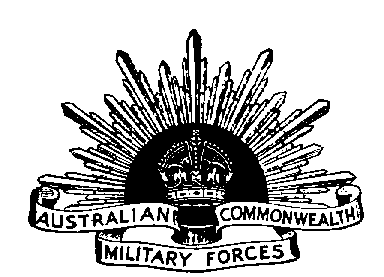


ART03644 Coates, George, Brigadier General Cecil Foott (1921), oil on canvas, 71.1 x 60.8 cm, AWM copyright
Cecil Henry Foott was born on 16 January 1876 at Bourke, NSW, the son of a station owner. He was educated at Toowoomba and Brisbane Grammar and qualified as a mechanical engineer.
In 1895, Foot was commissioned into the Queensland Militia Garrison Artillery as a second lieutenant. The following September he was commissioned as a lieutenant in the Permanent Military Forces, in the Queensland Artillery. In July 1901 he was promoted to captain in the Royal Australian Artillery.
In 1902 Foott transferred to the Royal Australian Engineers. After a year of training in England in 1908, he became Chief Engineer in Victoria in 1909. He was promoted to major on 1 August 1909, served as Director of Works from 1910 to 1911 and then as Director of Engineers from 1911-12. In 1912-13 he attended the Staff College at Camberley, England, and was still on duty in the UK on the staff of Southern Command when the war broke out.
Being one of only six staff college graduates in the Army (the others being Majors E. F. Harrison, E. H. Reynolds and C. B. B. White and Captains T. A. Blamey and J. D. Lavarack), this made him in demand for staff duties and Bridges immediately requested him for the 1st Division staff as Deputy Adjutant and Quartermaster General (DAQMG). This part of the division, staff was concerned with administration and logistics. Foott joined the staff in Egypt in January 1915. Unlike his immediate superior, the DAA & QMG, Major J. Gellibrand, Foott had never actually served on a headquarters staff before.
The pace of active service at Gallipoli, an administrative nightmare if ever was one, was too strenuous for Foott's superior, the Assistant Adjutant and Quartermaster General (AA & QMG), Lieutenant Colonel W. G. Patterson, another regular officer, who suffered a nervous breakdown and was evacuated on 28 April 1915. On 7 May 1915, Patterson was replaced by Lieutenant Colonel J. K. Forsyth. Foott acted as AA & QMG for a time in May while Forsyth was acting commander of the 2nd Brigade, and became permanent AA & QMG and was promoted to lieutenant colonel on 26 July 1915 when Forsyth was appointed to the permanent command of the 2nd Brigade.
Foott was determined that the men should always be supplied properly, and made a point of letting the officers of the Lines of Communication, living palatially on board the Aragon, know exactly what he thought of them whenever they placed obstacles in his way. He remained in the post for two years. In France he found the logistics far more complex, but much better organised, and increasingly free of shortages, he was able to deliver there a quality of service that he had never been able to achieve at Gallipoli.
On 23 July 1917 Foott became AA & QMG of the AIF Depots in the UK, with the temporary rank of brigadier general. Then on 17 March 1918 he became Chief Engineer of the Australian Corps. It was his first engineering post since before the war. Foott called conferences of his engineers and tried to build up a sense of esprit amongst the corps. Increasingly, the engineering effort was driven by Corps, as the engineers attempted to keep the troops and supplies moving forwards.
After the war ended, Foott became Deputy Director of Repatriation, working under Monash. Foott himself returned to Australia in November 1919.
Foott became a colonel and honorary brigadier general in the staff corps. He served at first in the Quartermaster General's Branch at Army HQ. In 1926 he became Commandant of the 1st Military District in Queensland. Then in 1930 he became Commandant of the 3rd Military District and commander of the 4th Division in Victoria.
In July 1931, Foott was transferred to the Reserve of Officers. He was placed on the Retired List in February 1936 as an honorary brigadier general.
He died on 27 June 1942 and was buried at Berwick Cemetery.
Foott was an officer of great ability whose work at various staff posts contributed to the efficiency and fighting ability of the force.
Sources: Australian Dictionary of Biography, 1899-1939, Vol 11, pp. 536-537; AWM183/20
Page created by Ross
Mallett
ross@metva.com.au
Last update 8 June 2010